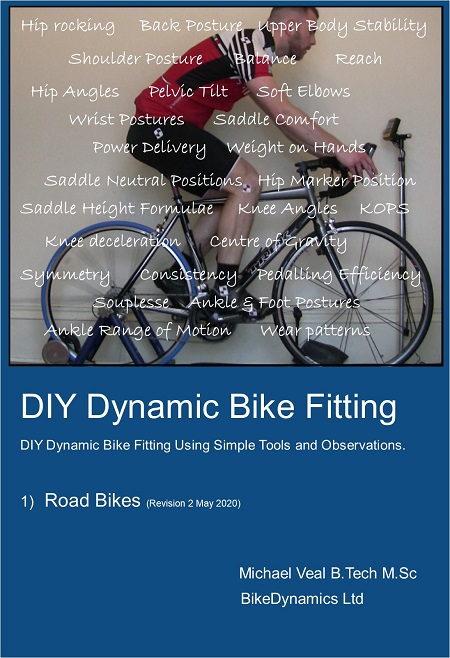Cycling Knee Pain
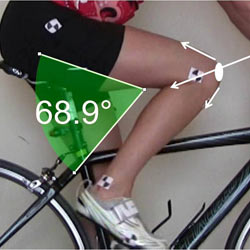
Patella Shear Forces
A low saddle height will mean that the knee angle is too tight at the top of the stroke. When the cranks are approximately vertical, the quads become the dominant muscle group, effectively pushing the foot over the top. The quads attach onto the tibial tuberosity via a shared tendon that encloses the patella (kneecap).
When the quads contract, forces are applied in the direction shown, giving a resultant force pulling the patella against the femur. The shear forces acting at this interface will be dependent upon the efforts being expended and the angle between femur and tibia. As these forces increase, so does the likelihood of tendonitis and harmful stresses in the cartilage behind the kneecap.The BikeDynamics recommendation for the minimum knee angle shown here is to be above 70°
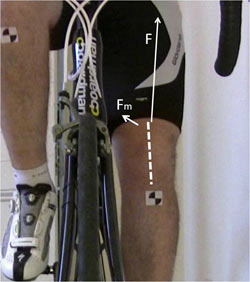
Patella Tracking
The forces (F) acting on the patella are primarily along the direction of the femur (due to muscles rectus femoris and the medial and lateral vasti). The groove in which the patella glides is along the vertical dotted line shown here. To prevent the patella scraping against the sides of the femur there needs to be a corrective force applied in the direction shown (Fm), which is the job of vastus medialis.
Using electrical recording of muscle activity, we know that vastus medialis is most active during the later stages of leg extension, presumably due to an evolutionary benefit to walking and running. If the saddle is too low, there will not be enough leg extension to get the vastus medialis firing adequately, potentially causing patella misalignment in conjunction with the high shear forces noted previously. Over a period of time, and provided the knee pain is not serious enough to prevent riding, the other three quads might strengthen disproportionally to vastus medialis, making the problem even worse. An added problem is that this muscle is weakened extremely quickly when the knee is injured, often needing specialist training programmes applied to the extended knee.
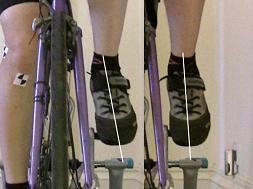
Cleat Misalignment
A very common cause of knee pain is misalignment of the cleats, causing the foot to be excessively toed in or out. Ideally the foot will be allowed to adopt its neutral position with adequate float each side to accommodate any rotation whilst pedalling.
If the foot is held in an unnatural posture, the tibia will be rotated, again causing poor patella tracking and unnecessary strains on knee ligaments. If the foot is excessively toed in, this will contribute to the tension in the illiotibial band (ITB) a fibrous connective tissue that runs along the thigh and attaches to the tibia. This band crosses the knee joint, with our bodies providing an anti-friction mechanism in the shape of a fluid filled sac called a bursa. Excessive tension in the ITB can lead to inflammation (Bursitis) and knee pain.
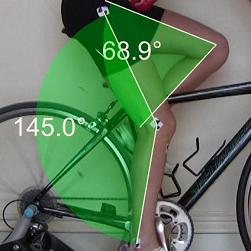
Cranks too Long
If the crank arms are too long for your leg length, the knee joint will be too tight at the top of the stroke and shear forces increased as discussed above. In this case though, the saddle might not be too low, but in the right place to give suitable knee angles at maximum extension.
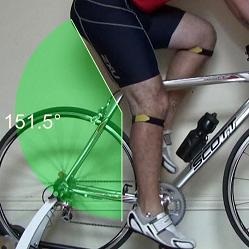
Saddle Too High
A saddle that is too high is likely to cause problems at the hamstring insertion points and increase tension in the illiotibial band. Two of the three hamstrings attach on the medial (inner) side of the tibia, below and to the rear of the knee joint. The third inserts on the lateral (outer) side of the tibia.
If the saddle is too high, the hamstrings will be over-stretched possibly causing tendonitis or bursitis at the attachment points. A tight illiotibial band can cause inflammation where the band crosses the knee joint and contribute to patella misalignment. Unfortunately, a high saddle can also cause anterior knee pain due to mechanisms such as Fat Pad irritation.
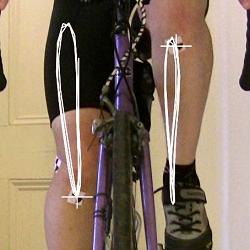
Knee Lateral Displacement
Many cyclists have very large lateral movements of their knees and suffer no ill effects at all. Others do suffer discomfort, either a degenerative condition of the joint menisci, or more usually inflammation of knee ligaments, having to work hard to stabilise the joint.
A strong inward kick of the knee over the top of the stroke is associated with either an unsupported fore-foot varus or insufficient longitudinal arch support. Wedges between shoe and cleats and / or more supportive insoles should help.
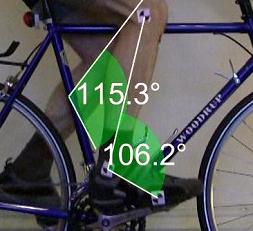
Excessive Dorsiflexion
There is an amazing diversity in what cyclists do with their ankles whilst pedalling. Toes can point up or down and the range of ankle movement between the top and bottom of the stroke can range from -10° to +30°. A 'normal' ankle behaviour would be to undergo a small amount of dorsiflexion as the power is applied, followed by approx. 15°-20° of plantarflexion as the leg is fully extended. High levels of ankle dorsiflexion can cause large knee displacements, usually when the cranks are approximately horizontal and loads are at their highest.
Under high efforts, the heel may also stay low around the bottom of the stroke, stretching the hamstrings and calf muscles that attach behind the knee.
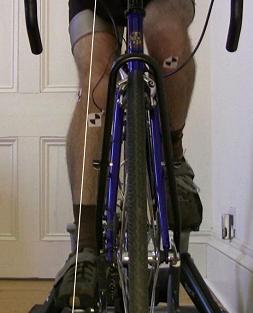
Vertical Offset
Although bike frames come in a variety of sizes, the width of the pedal spacing across the bike is pretty much the same for everybody. This spacing (often called Q factor) appears to be optimised for average sized gentlemen. Unfortunately, very slim people can find this spacing much wider than their hips, especially if using an even wider triple chainset as shown here.
As the applied loads from knees to pedals are not vertical, there is a resultant lateral force pushing the knee inboard, causing undesirable stresses at the joint. Similarly, wide hipped people can also suffer, usually from ITB related issues as the feet are held too close together. Although not straightforward, vertically aligning the hip knee and feet can often help resolve knee and foot pain.
| Location | Cause | Solution |
|---|---|---|
| Anterior Knee or Behind Kneecap | Tendonitis Patella misalignment |
Raise saddle Fit shorter cranks Ensure foot is in its natural position Vastus medialis strengthening exercise. |
| Medial knee pain | Menisci degeneration Ligament strain |
Bring feet inboard Ensure foot is in natural position Use pedals with less float Support fore-foot varus Increase arch support |
| Lateral Knee pain | Illiotibial band Menisci degeneration |
Move feet outboard Ensure foot is in natural position Reduce saddle height Support fore-foot varus ITB stretching exercises. |
| Posterior Knee pain | Hamstring over-extension | Reduce saddle height Increase arch support Hamstring stretching exercise. |
| Anterior Knee pain | Fat Pad irritation | Reduce saddle height Quad stretching exercise. |
DIY Dynamic Bike Fitting
You may be interested in our downloadable DIY guide.
49 Page PDF download describing all the observations, simple measurements and calculations required to do your own Dynamic Bike Fits.
Revision 2 released May 2020.
Contains updated male and female saddle height calculators and new information on male / female leg length proportions. Plus a new section to assist with saddle choice and improving comfort.
British Pound, Euro and US Dollar payments are processed by PayPal and all major credit cards are accepted. You will receive an email confirming your payment and will be automatically redirected to a page where you can download the ebook. The ebook is in PDF format so you will need to have a copy of Adobe Acrobat Reader or a similar PDF reader to read the ebook.

